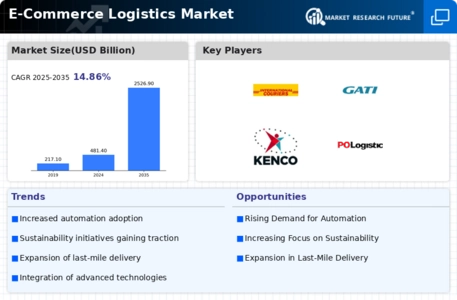Rising E-Commerce Sales
The E-Commerce Logistics Market is experiencing a notable surge in sales, driven by the increasing consumer preference for online shopping. In recent years, e-commerce sales have shown a consistent upward trajectory, with estimates indicating that they could reach trillions in revenue. This growth necessitates efficient logistics solutions to manage the rising volume of orders. As more businesses transition to online platforms, the demand for logistics services that can handle last-mile delivery, warehousing, and inventory management is likely to intensify. Consequently, logistics providers are compelled to innovate and enhance their service offerings to meet the evolving needs of e-commerce businesses, thereby propelling the E-Commerce Logistics Market forward.
Technological Advancements
Technological advancements play a pivotal role in shaping the E-Commerce Logistics Market. Innovations such as artificial intelligence, machine learning, and automation are revolutionizing logistics operations. These technologies enable companies to optimize their supply chains, improve delivery times, and enhance customer satisfaction. For instance, AI-driven analytics can predict demand patterns, allowing logistics providers to allocate resources more effectively. Furthermore, the integration of robotics in warehousing operations is streamlining processes and reducing operational costs. As these technologies continue to evolve, they are expected to drive efficiency and scalability within the E-Commerce Logistics Market, making it more competitive and responsive to market demands.
Expansion of E-Commerce Platforms
The expansion of e-commerce platforms is significantly influencing the E-Commerce Logistics Market. As more retailers and brands establish an online presence, the demand for logistics services is expected to grow. This trend is particularly evident in emerging markets, where internet penetration and smartphone usage are on the rise. The proliferation of e-commerce platforms creates a need for robust logistics networks capable of supporting diverse product offerings and delivery options. Consequently, logistics providers are likely to expand their service capabilities and geographic reach to accommodate the increasing volume of online transactions. This expansion is anticipated to drive innovation and competition within the E-Commerce Logistics Market.
Consumer Expectations for Fast Delivery
In the E-Commerce Logistics Market, consumer expectations for fast and reliable delivery are at an all-time high. Shoppers increasingly demand shorter delivery windows, often expecting same-day or next-day delivery options. This trend compels logistics providers to enhance their operational capabilities and invest in infrastructure that supports rapid fulfillment. According to recent data, a significant percentage of consumers are willing to pay extra for expedited shipping, indicating a willingness to prioritize speed over cost. As a result, logistics companies are exploring innovative solutions, such as micro-fulfillment centers and advanced routing technologies, to meet these expectations and remain competitive in the E-Commerce Logistics Market.
Sustainability and Eco-Friendly Practices
Sustainability has emerged as a critical driver in the E-Commerce Logistics Market. Consumers are increasingly aware of the environmental impact of their purchases and are favoring companies that adopt eco-friendly practices. This shift in consumer behavior is prompting logistics providers to implement sustainable solutions, such as electric delivery vehicles and optimized packaging materials. Moreover, regulatory pressures are encouraging businesses to reduce their carbon footprints. As a result, logistics companies are investing in green technologies and practices to align with consumer values and regulatory requirements. This focus on sustainability not only enhances brand reputation but also positions companies favorably within the E-Commerce Logistics Market.


















Leave a Comment